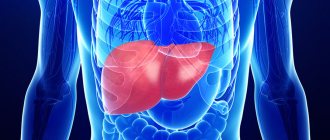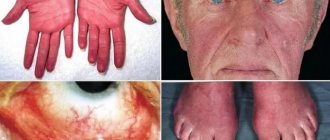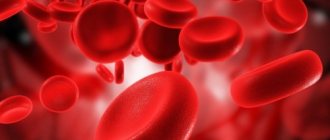Red blood cells produced in the bone marrow are called erythrocytes. Their transport function allows you to deliver oxygen to tissues at the cellular level and take carbon dioxide to the lungs. In addition to the main functionality, they take part in water-salt metabolism and regulation of blood acidity levels. For the normal functioning of the body, their quantity must correspond to age standards.
Normal indicators
The level of red blood cells contained in the bloodstream depends on the gender and age group of the patient. For a healthy person, the following level is acceptable:
- women – 3.7-4.7*1012 per liter;
- men – 4-5.1*1012 per 1 liter.
In childhood, the concentration of corpuscles constantly changes; for each month or day of a newborn’s life, there is a certain standard. Small fluctuations are observed after the first year of life, but the values are not particularly different from the same data for adults. At 12-13 years of age, the indicator is equal to adult values.
How are obstructive sleep apnea and erythrocytosis related?
Poor ventilation of the lungs is one of the main reasons for the increase in the number of red blood cells in the blood. For example, if a person suffers from obstructive sleep apnea, his body has to experience oxygen starvation every night. Regular oxygen deprivation during sleep stimulates the production of additional red blood cells, even if during the daytime ventilation is sufficient and the oxygen concentration in the blood is within normal limits. Therefore, if there is an increase in the level of red blood cells that is incomprehensible at first glance, you should always think about possible sleep apnea.
Classification Features
There are two types of erythrocytosis:
- Primary hereditary – refers to genetic pathologies, is rare. The source of the development of the disease is the low susceptibility of oxygen receptors in the kidneys and increased levels of erythropoietin. A sign of the disease is a pronounced loss of strength, attacks of dizziness, a change in the standard shade of the skin and mucous membranes into purple shades, and reduced blood clotting.
- Secondary or acquired - provoked by oxygen starvation of cells, occurs against the background of neoplasms in the liver, kidneys, and respiratory organs.
If the primary form of pathology is ignored, there is a risk of vascular complications, including thrombus formation. The problem is related to changes in the rate of blood clotting.
Not just sleep apnea
However, not only sleep apnea leads to secondary erythrocytosis, it is also caused by other diseases associated with pulmonary hypoventilation and oxygen starvation. Hypoventilation of the lungs during sleep in obesity is another common cause of erythrocytosis. In obese people, erythrocytosis and high hemoglobin levels are typical symptoms detected in blood tests.
Bronchial asthma can cause secondary erythrocytosis, especially in severe cases of the disease. This disease also leads to disruption of normal ventilation of the lungs during the day, and during sleep it causes even greater oxygen starvation, especially in the presence of night attacks.
Primary sources of increasing values
Changes of physiological nature are provoked by:
- severe emotional stress;
- severe dehydration;
- long-term sports activities;
- living in high mountain areas.
The pathological form of erythrocytosis is associated with:
- with erythremia - tumor damage to the hematopoietic organs;
- heart defects - when arterial and venous blood is mixed, there is an insufficient supply of oxygen to the tissues; to compensate for the deviation, the bone marrow begins to produce a larger number of red blood cells;
- neoplasms in the kidneys, pituitary gland, adrenal glands or liver - the organs are responsible for the disposal of old elements in the blood, the formation of the disease leads to the cessation of this function, the tests indicate a predominance of mature forms;
- diseases of the respiratory tract and heart, infectious pathologies - a large number of young or reticular types of elements are observed;
- primary pulmonary hypertension;
- Pickwick's syndrome caused by obesity, pulmonary insufficiency, high blood pressure.
Less dangerous sources of development of an increased number of red blood cells include:
- lack of digestive enzymes;
- dehydration due to heat or prolonged physical activity;
- low-quality water: with chlorine, contaminated, highly carbonated;
- vitamin deficiency or deficiency due to liver dysfunction;
- smoking.
Against the backdrop of a large number of reasons causing changes in tests, only a doctor can correctly determine the original source of the deviation.
Erythremia (polycythemia vera, erythrocytosis, Vaquez disease)
In the early stages of the disease, there are usually no symptoms. However, as changes in the blood supply system increase, patients complain of a vague feeling of fullness in the head, headaches, and dizziness. Other symptoms appear depending on which body systems are affected. Paradoxically, hemorrhage can be a complication of erythremia.
The advanced stage is characterized by more pronounced clinical symptoms. The most common and characteristic symptom is headaches, sometimes in the nature of painful migraines with blurred vision.
Many patients complain of pain in the heart, sometimes like angina pectoris, pain in the bones, in the epigastric region, weight loss, blurred vision and hearing, unstable mood, and tearfulness. A common symptom of erythremia is skin itching. There may be paroxysmal pain in the tips of the fingers and toes. The pain is accompanied by redness of the skin.
Upon examination, attention is drawn to the special red-cyanotic color of the skin with a predominance of dark cherry tone. Redness of the mucous membranes (conjunctiva, tongue, soft palate) is also noted. Due to frequent thrombosis of the extremities, darkening of the skin of the legs and sometimes trophic ulcers are observed. Many patients complain of bleeding gums, bleeding after tooth extraction, and bruises on the skin. In 80% of patients, there is an enlargement of the spleen: in the advanced stage it is moderately enlarged, in the terminal stage severe splenomegaly is often observed. Usually the liver is enlarged. Often in patients with erythremia, increased blood pressure is detected. As a result of malnutrition of the mucous membrane and vascular thrombosis, ulcers of the duodenum and stomach can occur. Vascular thrombosis plays an important role in the clinical picture of the disease. Thrombosis of the cerebral and coronary arteries, as well as the vessels of the lower extremities, is usually observed. Along with thrombosis, patients with erythremia are prone to the development of hemorrhages.
In the terminal stage, the clinical picture is determined by the outcome of the disease - liver cirrhosis, coronary thrombosis, a softening focus in the brain due to thrombosis of cerebral vessels and hemorrhages, myelofibrosis accompanied by anemia, chronic myeloid leukemia and acute leukemia.
The prognosis depends on the patient's age at diagnosis, treatment, and complications. Mortality is high in the absence of treatment and in cases where erythremia is combined with leukemia and other cancers.
Changes in childhood
A pathological increase in the number of red blood cells in children is associated with various factors:
- with a low level of oxygen in maternal blood - the anomaly manifests itself in newborns;
- regular exposure of the baby to tobacco smoke (passive smoking);
- living in high mountain areas;
- regular sports activities.
A list of probable sources of deviation in children is presented:
- congenital heart defects;
- bone marrow dysfunction;
- hypertension in the pulmonary circulation;
- blood pathologies;
- obstructive pulmonary lesions with a chronic course;
- acute bronchitis, rhinitis or allergies;
- obesity of the last two degrees;
- dehydration caused by vomiting or diarrhea;
- disruption of the adrenal cortex.
Serious diagnoses associated with changes in the number of red blood cells include cancer of the kidneys and liver. Erythrocytosis is not an independent disease; it indicates latent pathologies or the presence of external influence factors.
Treatment
Conservative therapy
Smokers are advised to give up the bad habit. The diet and physical activity regimen are selected taking into account the characteristics of the disease. Symptomatic treatment consists of bloodletting. To eliminate erythrocytosis, a course is prescribed, including 3-4 procedures with the simultaneous removal of 400-500 ml of blood.
When determining the need for manipulation, the compensatory role of erythrocytosis in patients with heart defects is taken into account; oxygen therapy is used according to indications, and antiplatelet agents are used. For renal pathologies, bloodletting is carried out until the hematocrit normalizes. In recent years, the procedure is performed less frequently than before, since studies indicate stimulation of the bone marrow and subsequent activation of hematopoiesis after bloodletting.
Etiopathogenetic therapy for hereditary erythrocytosis has not been developed. Antiplatelet agents, anticoagulants, and sometimes cytotoxic agents are recommended as symptomatic measures. Secondary erythrocytosis is eliminated by treating the underlying pathology:
- Kidney diseases
. For pyelonephritis, antibacterial and detoxification therapy, immunostimulants, and immunomodulators are indicated. Patients with glomerulonephritis are prescribed immunosuppressive therapy using cytostatics, glucocorticoids, NSAIDs, anticoagulants and antiplatelet agents. - Bronchopulmonary pathologies
. Bronchodilators and mucolytics are effective. During periods of exacerbation of inflammatory diseases, antibacterial agents are recommended. Patients with COPD and bronchial asthma need to use inhalers, nebulizers, and spacers. Anti-tuberculosis medications are effective for tuberculosis. - Endocrine disorders
. For diabetes mellitus, it is necessary to correct glucose levels by administering insulin or hypoglycemic agents. Hyperthyroidism requires thyreostatics. Itsenko-Cushing syndrome involves treatment with drugs that suppress steroidogenesis. For pituitary microadenomas, radiation therapy and dopamine agonists are effective.
Surgery
For secondary erythrocytosis, the following operations can be performed:
- Respiratory hypoxia
: drainage of the pleural cavity, thoracostomy, thoracoplasty, pleurectomy, lung resection. - Circulatory hypoxia
: aortic and pulmonary artery transplantation, Norwood operation, Fontan operation, heart transplantation. - Kidney pathologies
: bougienage, installation of stents, lithotripsy and removal of stones to restore urine passage, plastic hydronephrosis, excision of a kidney cyst, removal of a kidney tumor, kidney resection, nephrectomy. - Endocrine diseases
: resection of the thyroid lobe, hemithyroidectomy, removal of the thyroid gland, adrenalectomy, excision of a pituitary tumor.
Erythrocytosis is a reason to visit a pulmonologist!
If an increased content of red blood cells is detected in a person’s blood, and at first glance he does not suffer from any serious diseases, the doctor must ask: “Do you snore at night?” Snoring is one of the main signs of sleep apnea. When the walls of the upper respiratory tract fluctuate during night breathing, periodically blocking the access of air to the lungs, characteristic sounds appear that we are accustomed to calling snoring. That is why such a question from a doctor would be natural and very appropriate.
But, unfortunately, in real life it is asked by a very small number of specialists - simply because doctors are accustomed to solving the “daytime problems” of patients and do not correlate the quality of sleep with the daytime manifestations of diseases. Therefore, patients should think about themselves: if the laboratory test clearly indicates erythrocytosis, they should make an appointment with a pulmonologist. However, there is one small nuance - in this situation you will need not just a pulmonologist, but a somnologist who knows first-hand about the influence of sleep and the processes occurring in it on the human body, and also understands the intricacies and mechanisms of “night breathing”. Such a specialist will help you determine exactly how your breathing works not only during the day, but also at night and identify the causes of oxygen starvation, which leads to an increase in the number of red blood cells.
Such a doctor will conduct a comprehensive examination, help establish the true causes of erythrocytosis and, if necessary, individually select a CPAP therapy regimen - the newest and most effective method of treating snoring and sleep apnea.










